Minimization of Cross-Regulation in PV and Battery Connected Multi-Input Multi-Output DC to DC Converter
Abstract
1. Introduction
- The paper proposes the photovoltaic (PV) and battery connected MIMO positive Super-Lift Luo converter with high-voltage transfer gain, high power density, high efficiency, reduced ripple voltage, and current.
- Development of a PID controller for a DIDO hybrid energy system.
- Development of a PID controller DMPC for a DIDO hybrid energy system.
- The controller performance is analyzed and compared with a conventional PID controller to check the extent of reducing the cross-regulation and the time delay. The remaining structure of the paper comprises the following: Section 2 describes the working, and provides a state-space model of proposed converter. Section 3 discusses the comparisons of conventional PID controller with DMPC. Section 4 elaborates the design procedure of component selection. Section 5 discusses the simulation results and hardware results of the designed converter. Section 6 provides the conclusion of the analysis carried out in this paper.
2. Proposed Converter Topology
2.1. Converter Description
2.2. State Space Analysis of PSLLC Converter
Representation of State-Space Analysis
2.3. Small Signal Modeling of PSLLC Converters
2.4. Effect of Cross-Regulation in an Open Loop MIMO Structure of PSLLC Converter
3. Close Loop Controller
3.1. Conventional Controller
3.1.1. Decoupling Method
3.1.2. Design of PID Controller
3.2. Digital Model Predictive Controller (DMPC)
- The instantaneous value of inductor current and capacitor voltage are considered as the reference values which are represented as I*(k)L and V*(k)C.
- From the load side, the instantaneous values of inductor current and the capacitor voltage are measured and signified as I(k)L and V(k)C.
- These values are fed to the predictive model to find the predicted values of I(k + 1)L and V(k + 1)C.
- The error obtained by the reference value and the predicted values are measured and minimized by the cost function J for the entire control horizon.
- The optimal actuation is attained by minimizing the cost function J, and the corresponding switching state is produced, which controls the load switch effectively, thus minimizing the cross-regulation.
4. Design Procedure
- (a)
- The input voltage V1 and V2—40 V, 20V
- (b)
- The input current Iin —4 A
- (c)
- Ripple voltage—±0.1%
- (d)
- Ripple current—±5%
- (e)
- Switching frequency—100 KHz
- (f)
- Conduction mode—continuous
- (g)
- Duty cycle are taken in the range of (0.2–0.7)
- (h)
- The output voltage of the converter is in the range of (60–65) V
- (i)
- The output current is in the range of (2–3) A
- (j)
- The minimum value of the inductor is calculated using the formula: = 1 mH
- (k)
- The minimum value of the capacitance is calculated using the formula: where C = C01 = C02 = 680 µF
- (l)
- The presence of cross-regulation in the system in MATLAB Simulink in open loop condition is verified and estimated. By means of a circuit breaker, a step change across the load R01 is introduced during the simulation runtime, using parallel resistance connection. This load variation causes a subsequent variation in the voltage and current across R02 which is calculated as follows:
5. Performance Analysis Based on Simulation and Experimental Results
5.1. Simulation of PID Controller
5.2. Simulation of DMPC Controller
5.3. Comparisons of Various Cases with PID Controller and DMPC Controller
5.4. Comparison with Existing Works
5.5. Experimental Results and Discussion
- Case 1. Step change at load voltage V01:
- Case 2. Step change at load voltage V02:
- Case 3. Step change in input voltage variations:
6. Conclusions
- This paper proposes the PV and battery-connected MIMO positive Super-Lift Luo Converter with high-voltage transfer gain, high power density, high efficiency, reduced ripple voltage and current.
- The proposed DMPC controller has the advantage of fast dynamic response and suppression of cross-regulation by controlling the load switches. The decoupling method is preferred to overcome the interaction of the proposed hybrid DIDO system with renewable energy resources.
- The DMPC controller shows greater performance in cross-regulation and sensitivity index when compared with existing literature.
- Thus, MIMO controller is implemented in a DIDO hybrid energy system, which can be interfaced for electric vehicle application.
Author Contributions
Funding
Conflicts of Interest
References
- Rehmani, M.H.; Reisslein, M.; Rachedi, A.; Erol-Kantarci, M.G.; Radenkovic, M.G. Integrating Renewable Energy Resources into the Smart Grid: Recent Developments in Information and Communication Technologies. IEEE Trans. Ind. Inform. 2018, 14, 2814–2825. [Google Scholar] [CrossRef]
- Suresh, K.; Chellammal, N.; Bharatiraja, C.; Sanjeevikumar, P.; Blaabjerg, F.; Nielsen, J.B.H. Cost-efficient nonisolated three-port DC-DC converter for EV/HEV applications with energy storage. Int. Trans. Electr. Energy Syst. 2019, 29, 1. [Google Scholar] [CrossRef]
- Xiang, W.; Lin, W.; Miao, L.; Wen, J. Power balancing control of a multi-terminal DC constructed by multiport front-to-front DC–DC converters. IET Gener. Transm. Distrib. 2017, 11, 363–371. [Google Scholar] [CrossRef]
- Sidorov, D.; Panasetsky, D.; Tomin, N.; Karamov, D.N.; Zhukov, A.; Muftahov, I.; Dreglea, A.; Liu, F.; Li, Y. Toward Zero-Emission Hybrid AC/DC Power Systems with Renewable Energy Sources and Storages: A Case Study from Lake Baikal Region. Energies 2020, 13, 1226. [Google Scholar] [CrossRef]
- Anuradha, C.; Chellammal, N.; Maqsood, S.; Vijayalakshmi, S. Design and Analysis of Non-Isolated Three-Port SEPIC Converter for Integrating Renewable Energy Sources. Energies 2019, 12, 221. [Google Scholar] [CrossRef]
- Karthikeyan, M.; Elavarasu, R.; Ramesh, P.; Bharatiraja, C.; Padmanaban, S.; Mihet-Popa, L.; Mitolo, M. A Hybridization of Cuk and Boost Converter Using Single Switch with Higher Voltage Gain Compatibility. Energies 2020, 13, 2312. [Google Scholar] [CrossRef]
- Chen, H.; Zhang, Y.; Ma, D. A SIMO Parallel-String Driver IC for Dimmable LED Backlighting with Local Bus Voltage Optimization and Single Time-Shared Regulation Loop. IEEE Trans. Power Electron. 2011, 27, 452–462. [Google Scholar] [CrossRef]
- Ma, N.D.; Ki, N.W.-H.; Tsui, N.C.-Y.; Mok, P.K.T. Single-inductor multiple-output switching converters with time-multiplexing control in discontinuous conduction mode. IEEE J. Solid State Circuits 2003, 38, 89–100. [Google Scholar] [CrossRef]
- Ma, D.; Ki, W.H.; Tusi, C.Y. A pesudo-CCM/DCM SIMO switching converter with freewheel switching. IEEE J. Solid State Circuits 2003, 38, 1007–1014. [Google Scholar]
- Le, H.-P.; Chae, C.-S.; Lee, K.-C.; Wang, S.-W.; Cho, G.-H. A Single-Inductor Switching DC–DC Converter with Five Outputs and Ordered Power-Distributive Control. IEEE J. Solid State Circuits 2007, 42, 2706–2714. [Google Scholar] [CrossRef]
- Shao, H.; Li, X.; Tsui, C.-Y.; Ki, W.-H. A Novel Single-Inductor Dual-Input Dual-Output DC–DC Converter with PWM Control for Solar Energy Harvesting System. IEEE Trans. VLSI Syst. 2013, 22, 1693–1704. [Google Scholar] [CrossRef]
- Qian, Y.; Zhang, H.; Chen, Y.; Qin, Y.; Lu, D.; Hong, Z. A SI-DIDO DC–DC converter with dual-mode and programmable-capacitor-array MPPT control for thermoelectric energy harvesting. IEEE Trans. Circuits Syst. II Express Briefs 2017, 64, 952–956. [Google Scholar]
- Trevisan, D.; Mattavelli, P.; Tenti, P. Digital Control of Single-Inductor Multiple-Output Step-Down DC–DC Converters in CCM. IEEE Trans. Ind. Electron. 2008, 55, 3476–3483. [Google Scholar] [CrossRef]
- Pizzutelli, A.; Ghioni, M. Novel control technique for single inductor multiple output converters operating in CCM with reduced cross-regulation. Appl. Power Electron. Conf. Expo. 2008, 1502–1507. [Google Scholar] [CrossRef]
- Patra, P.; Ghosh, J.; Patra, A. Control Scheme for Reduced Cross-Regulation in Single-Inductor Multiple-Output DC–DC Converters. IEEE Trans. Ind. Electron. 2013, 60, 5095–5104. [Google Scholar] [CrossRef]
- Dasika, J.D.; Bahrani, B.; Saeedifard, M.; Karimi, A.; Rufer, A. Multivariable Control of Single-Inductor Dual-Output Buck Converters. IEEE Trans. Power Electron. 2014, 29, 2061–2070. [Google Scholar] [CrossRef]
- Wang, Y.; Xu, J.; Zhou, G. A Cross Regulation Analysis for Single-Inductor Dual-Output CCM Buck Converters. J. Power Electron. 2016, 16, 1802–1812. [Google Scholar] [CrossRef]
- Huang, M.-H.; Chen, K.-H. Single-Inductor Multi-Output (SIMO) DC-DC Converters with High Light-Load Efficiency and Minimized Cross-Regulation for Portable Devices. IEEE J. Solid State Circuits 2009, 44, 1099–1111. [Google Scholar] [CrossRef]
- Behjati, H.; Davoudi, A. A Multiple-Input Multiple-Output DC–DC Converter. IEEE Trans. Ind. Appl. 2013, 49, 1464–1479. [Google Scholar] [CrossRef]
- Park, Y.-J.; Khan, Z.H.N.; Oh, S.J.; Jang, B.G.; Ahmad, N.; Khan, D.; Abbasizadeh, H.; Shah, S.A.A.; Pu, Y.; Hwang, K.C.; et al. Single Inductor-Multiple Output DPWM DC-DC Boost Converter with a High Efficiency and Small Area. Energies 2018, 11, 725. [Google Scholar] [CrossRef]
- Wang, B.; Zhang, X.; Ye, J.; Gooi, H.B. Deadbeat Control for a Single-Inductor Multiple-Input Multiple-Output DC–DC Converter. IEEE Trans. Power Electron. 2019, 34, 1914–1924. [Google Scholar] [CrossRef]
- Soman, D.E.; Leijon, M. Cross-Regulation Assessment of DIDO Buck-Boost Converter for Renewable Energy Application. Energies 2017, 10, 846. [Google Scholar] [CrossRef]
- Lindiya, A.; Subashini, N.; Karuppaiyan, V. Cross Regulation Reduced Optimal Multivariable Controller Design for Single Inductor DC-DC Converters. Energies 2019, 12, 477. [Google Scholar] [CrossRef]
- Kwak, S.; Park, J.-C. Model-Predictive Direct Power Control with Vector Preselection Technique for Highly Efficient Active Rectifiers. IEEE Trans. Ind. Informatics 2015, 11, 44–52. [Google Scholar] [CrossRef]
- Cortes, P.; Ortiz, G.; Yuz, J.I.; Rodriguez, J.; Vazquez, S.; Franquelo, L.G. Model Predictive Control of an Inverter with Output LC Filter for UPS Applications. IEEE Trans. Ind. Electron. 2009, 56, 1875–1883. [Google Scholar] [CrossRef]
- Karamanakos, P.; Geyer, T.; Manias, S. Direct Voltage Control of DC–DC Boost Converters Using Enumeration-Based Model Predictive Control. IEEE Trans. Power Electron. 2014, 29, 968–978. [Google Scholar] [CrossRef]
- Cheng, L.; Acuna, P.; Aguilera, R.P.; Jiang, J.; Wei, S.; Fletcher, J.E.; Lu, D.D.-C. Model Predictive Control for DC–DC Boost Converters with Reduced-Prediction Horizon and Constant Switching Frequency. IEEE Trans. Power Electron. 2018, 33, 9064–9075. [Google Scholar] [CrossRef]
- Kamalesh, M.; Senthilnathan, N.; Bharatiraja, C. Design of a Novel Boomerang Trajectory for Sliding Mode Controller. Int. J. Control. Autom. Syst. 2020, 18, 2917–2928. [Google Scholar] [CrossRef]
- Wang, B.; Kanamarlapudi, V.R.K.; Xian, L.; Peng, X.; Tan, K.T.; So, P.L. Model Predictive Voltage Control for Single-Inductor Multiple-Output DC–DC Converter with Reduced Cross Regulation. IEEE Trans. Ind. Electron. 2016, 63, 4187–4197. [Google Scholar] [CrossRef]
- Luo, F.L.; Ye, H. Hybrid split capacitors and split inductors applied in positive output super-lift Luo-converters. IET Power Electron. 2013, 6, 1759–1768. [Google Scholar] [CrossRef]
- Balaji, C.; Chellammal, N.; Sanjeevikumar, P.; Subramaniam, U.; Holm-Nielsen, J.B.; Leonowicz, Z.; Masebinu, S.O. Non-Isolated High-Gain Triple Port DC-DC Buck-Boost Converter with Positive Output Voltage for Photovoltaic Application. IEEE Access 2020, 8, 1. [Google Scholar] [CrossRef]
- Kamaraj, V.; Nallaperumal, C. Modified multiport Luo converter integrated with renewable energy sources for electric vehicle applications. Circuit World 2020, 46, 125–135. [Google Scholar] [CrossRef]
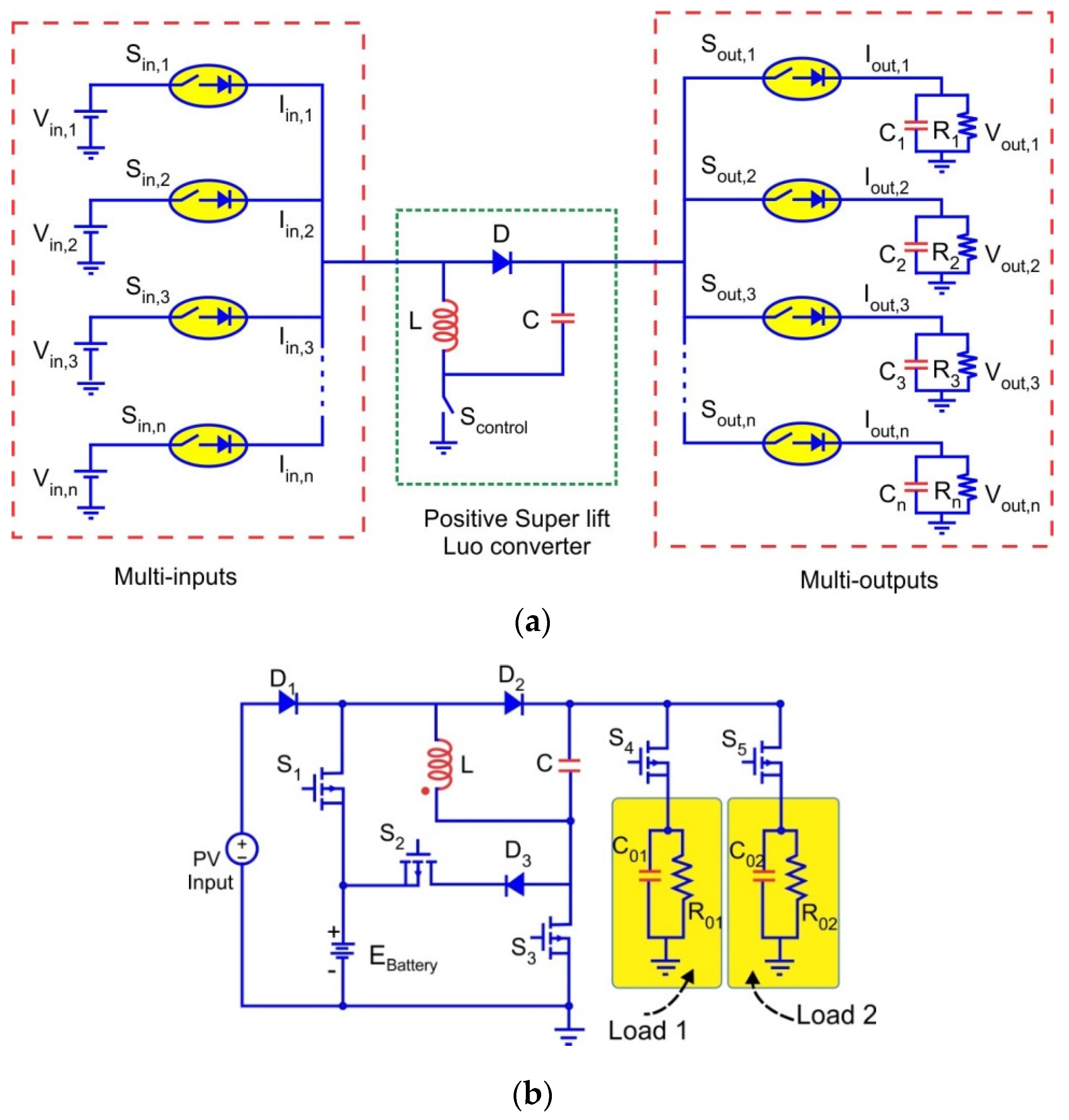
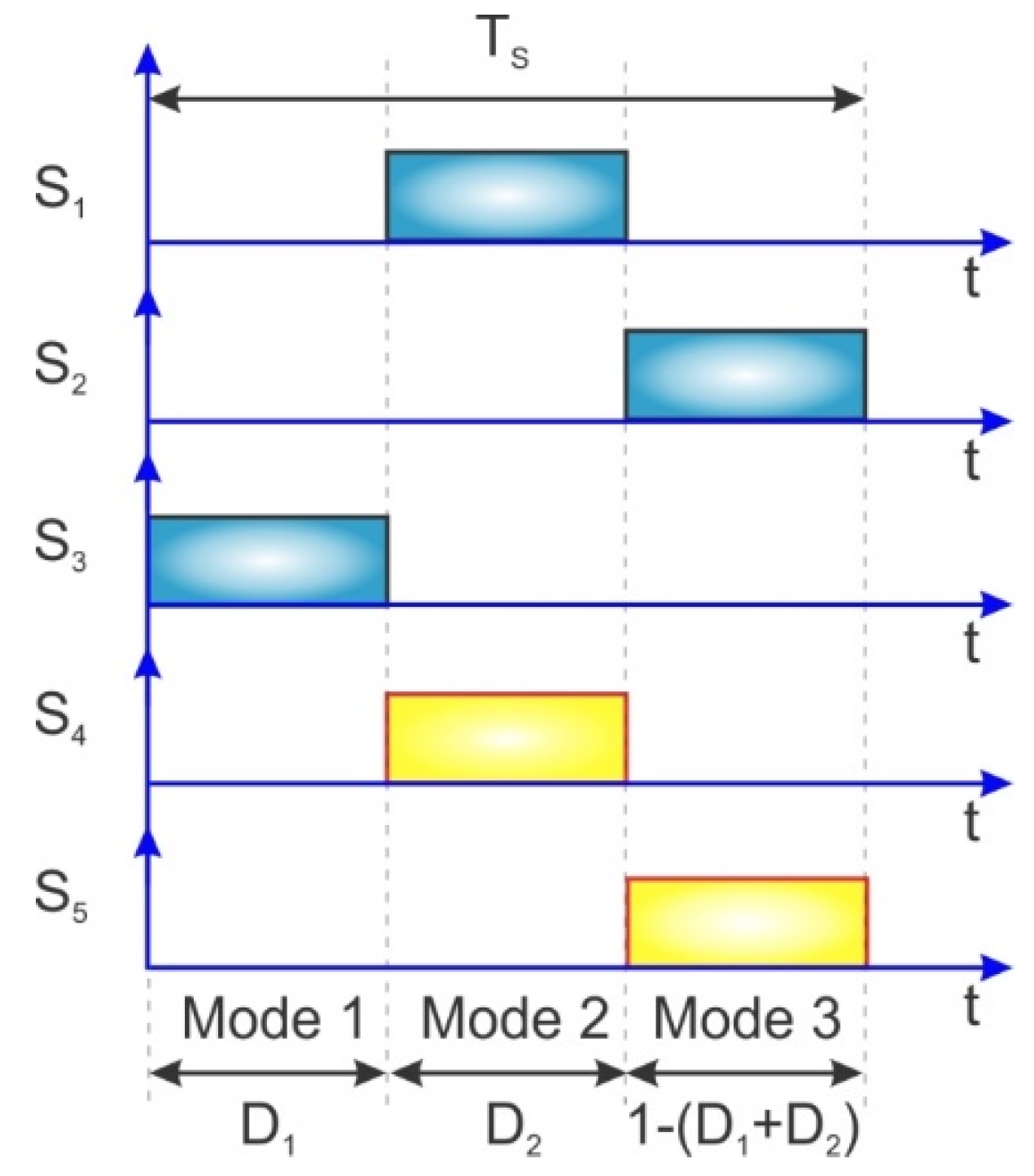
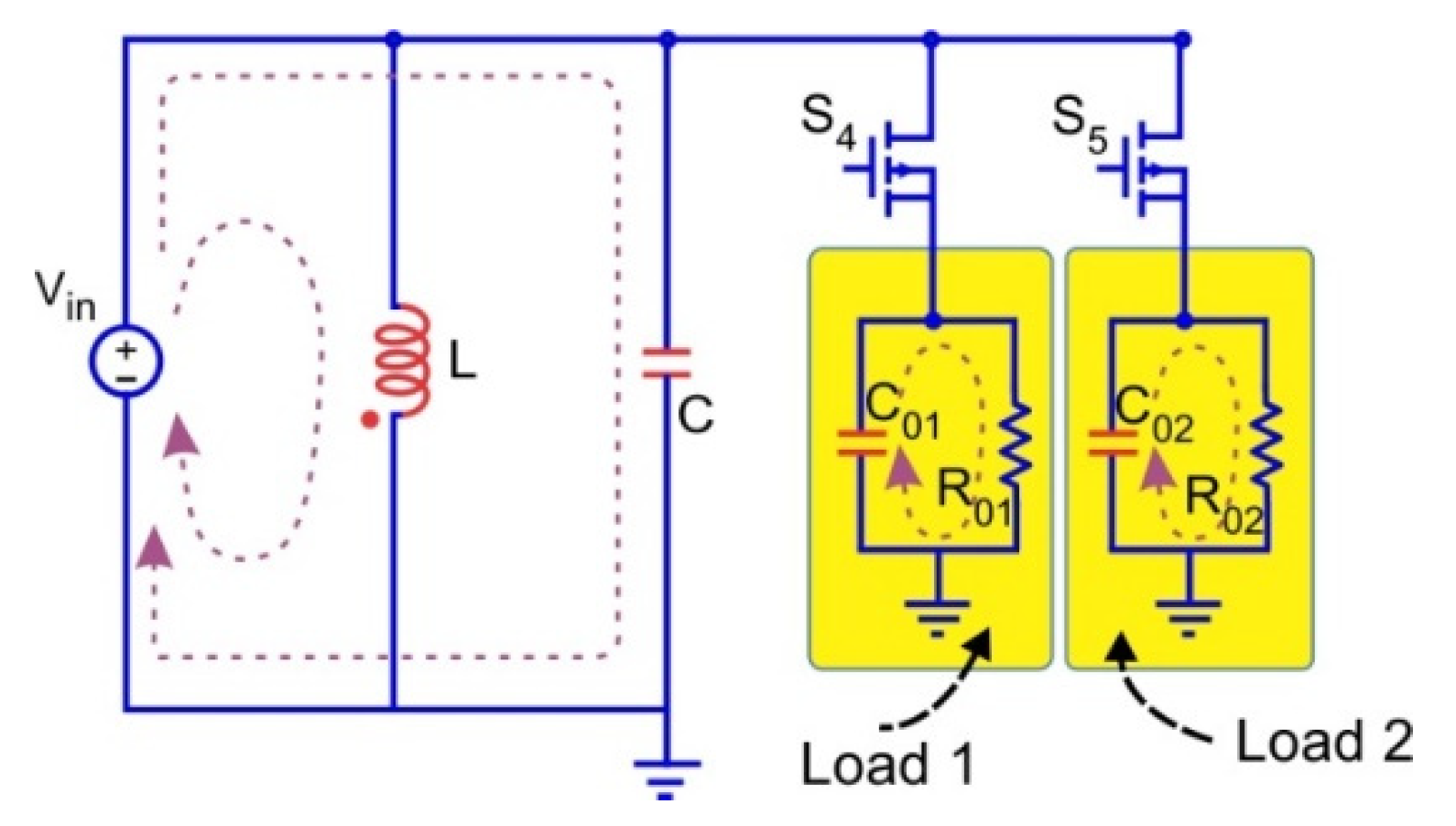
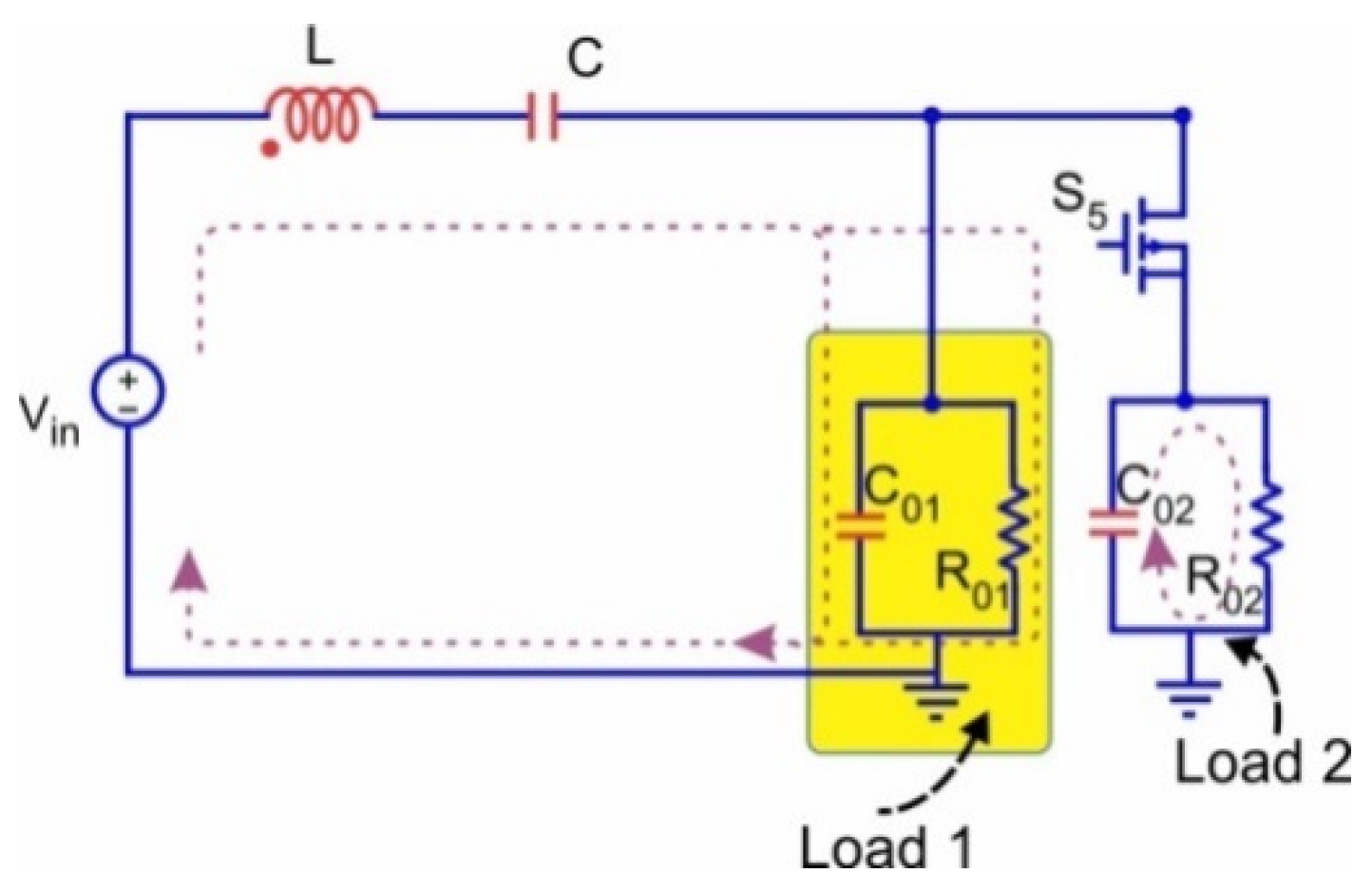
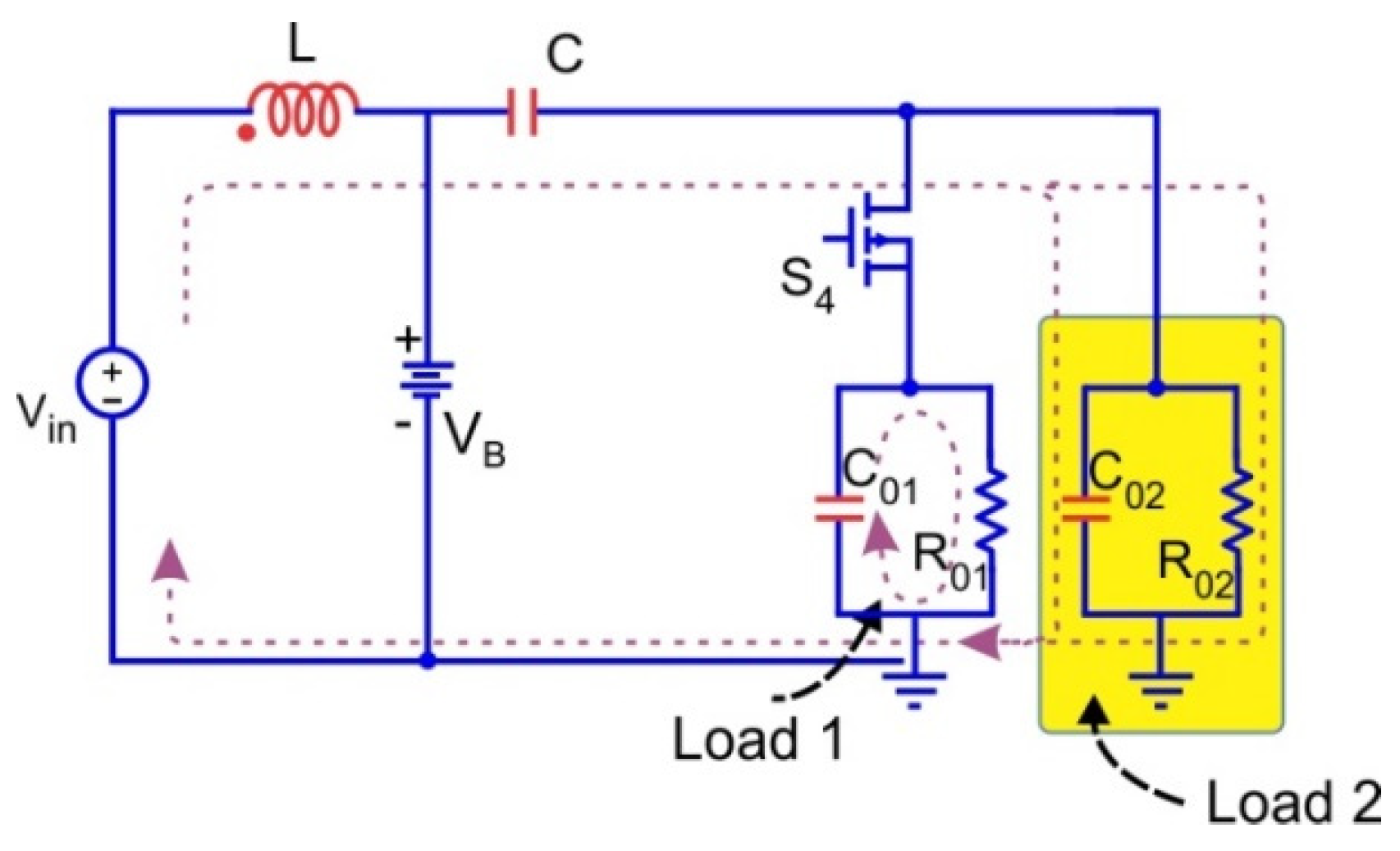



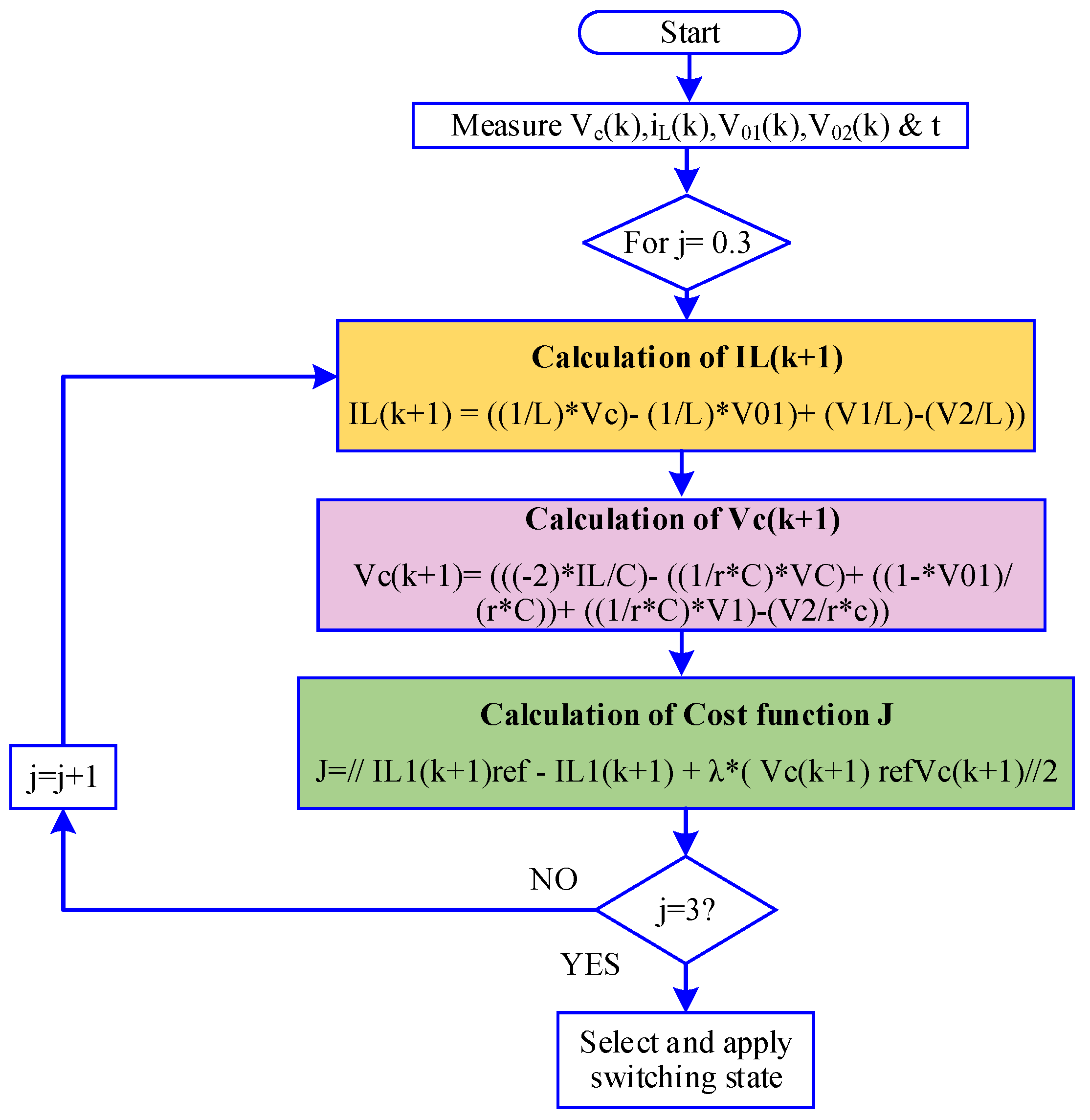

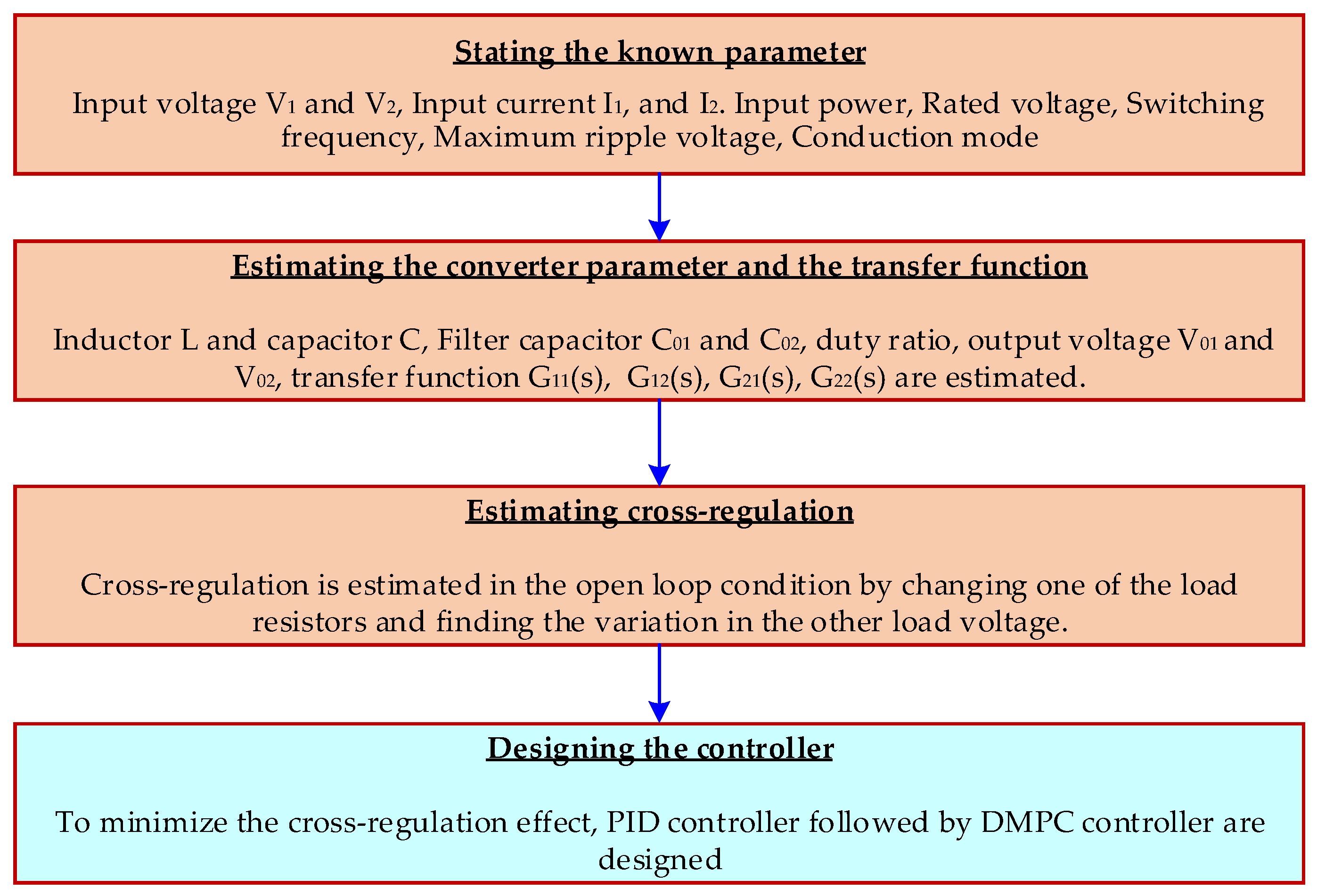
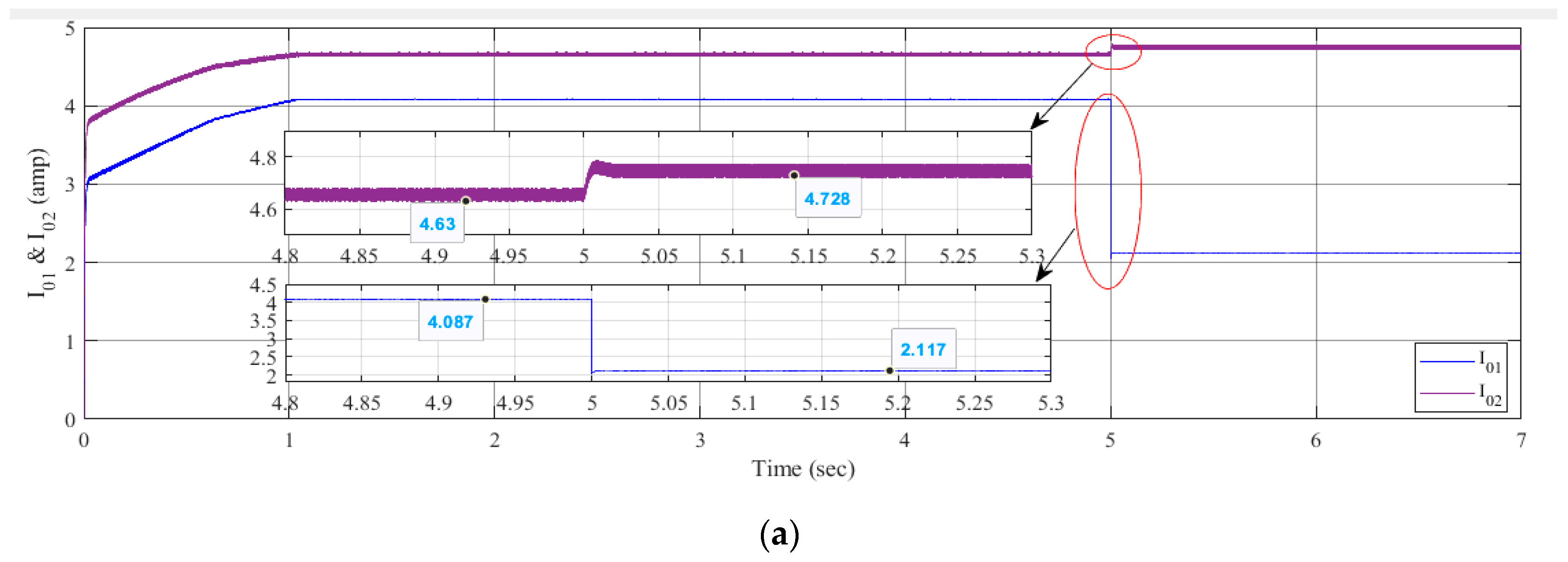

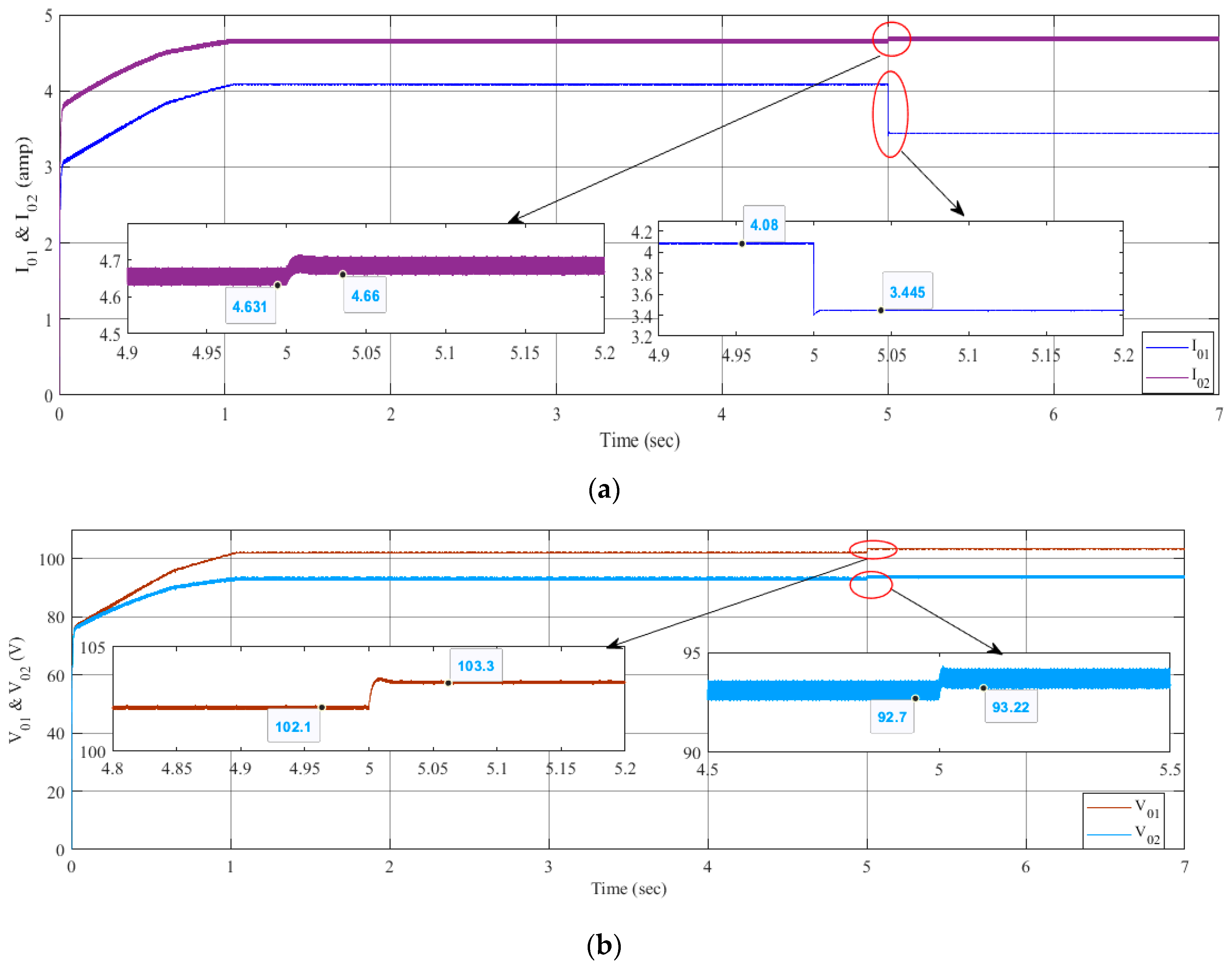
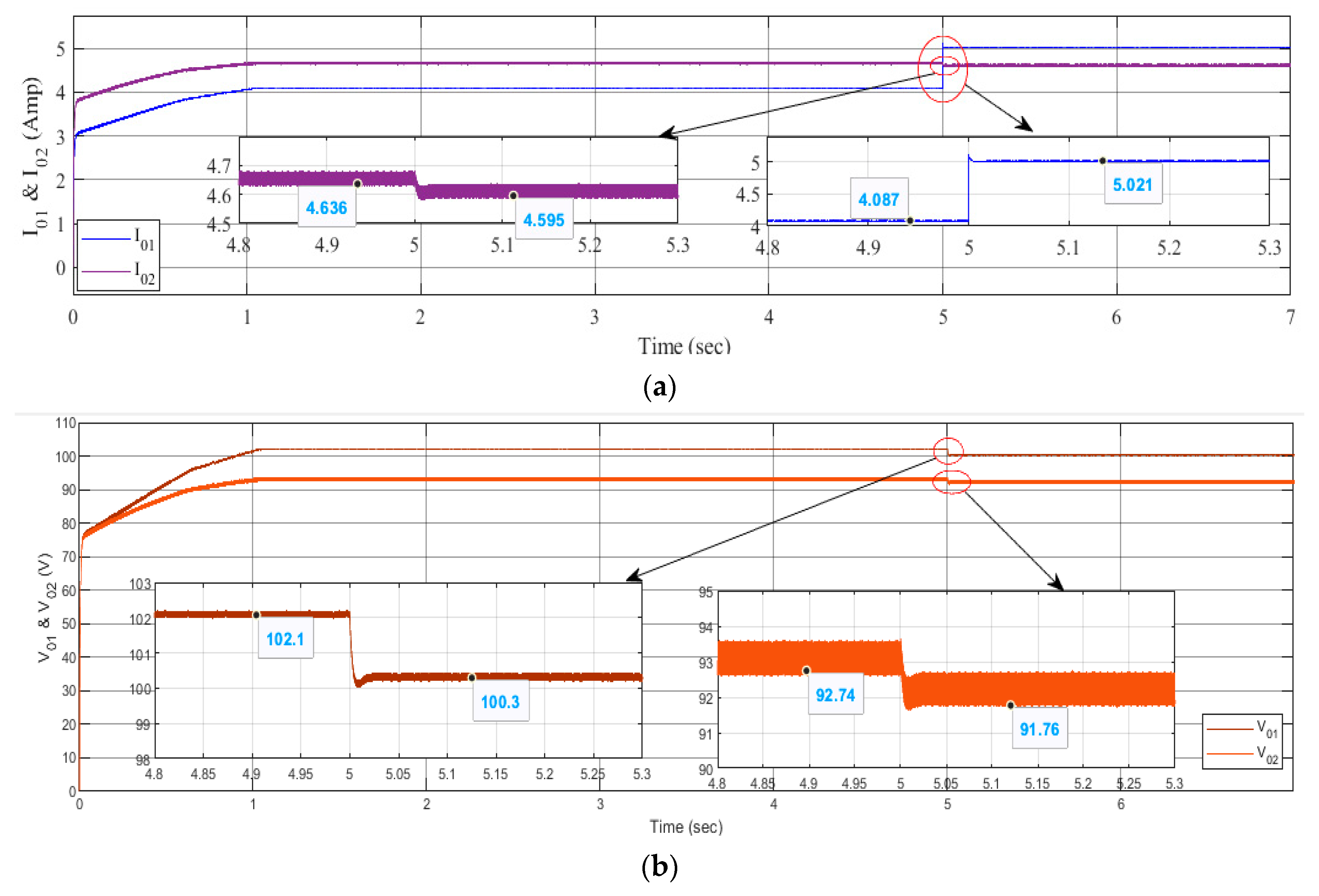
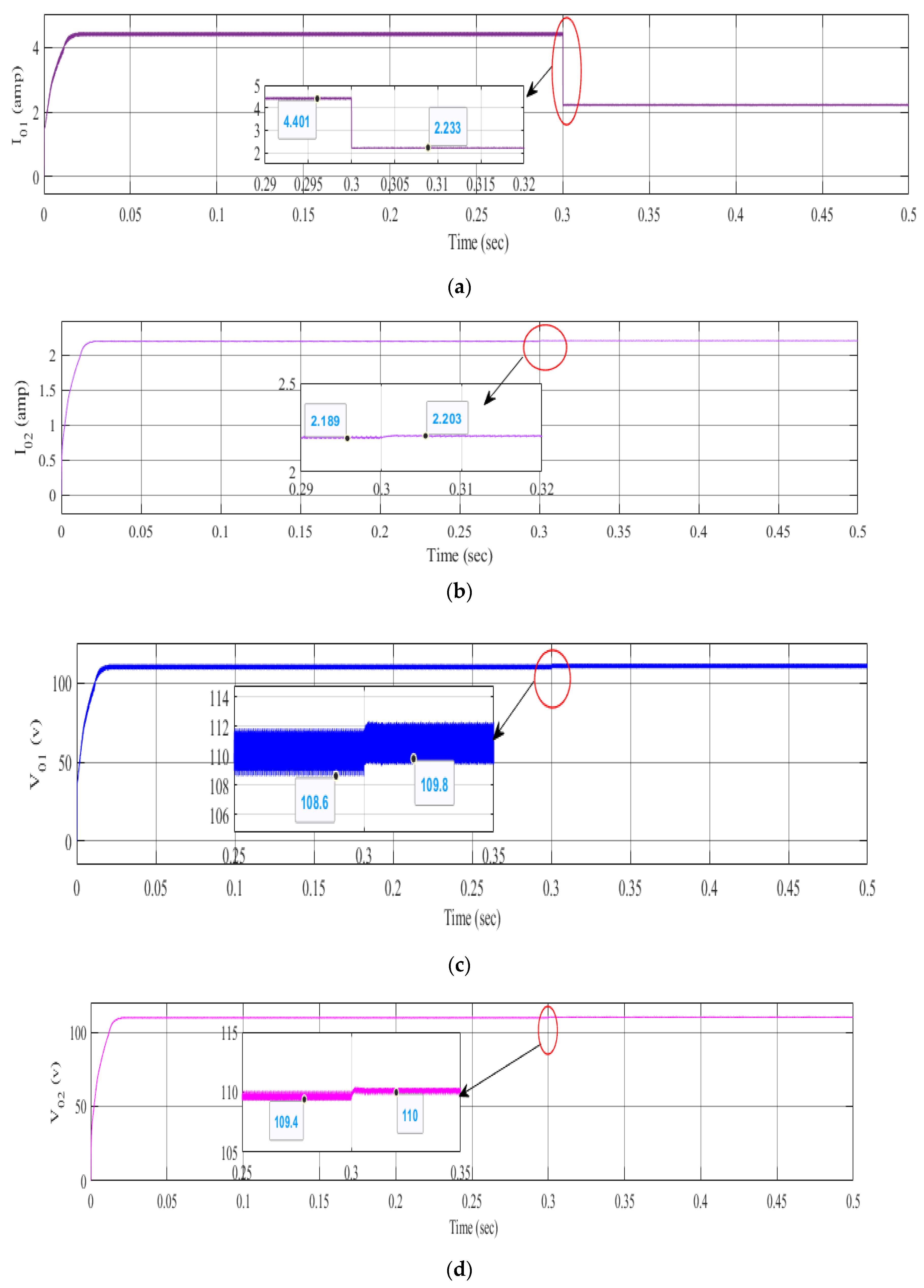
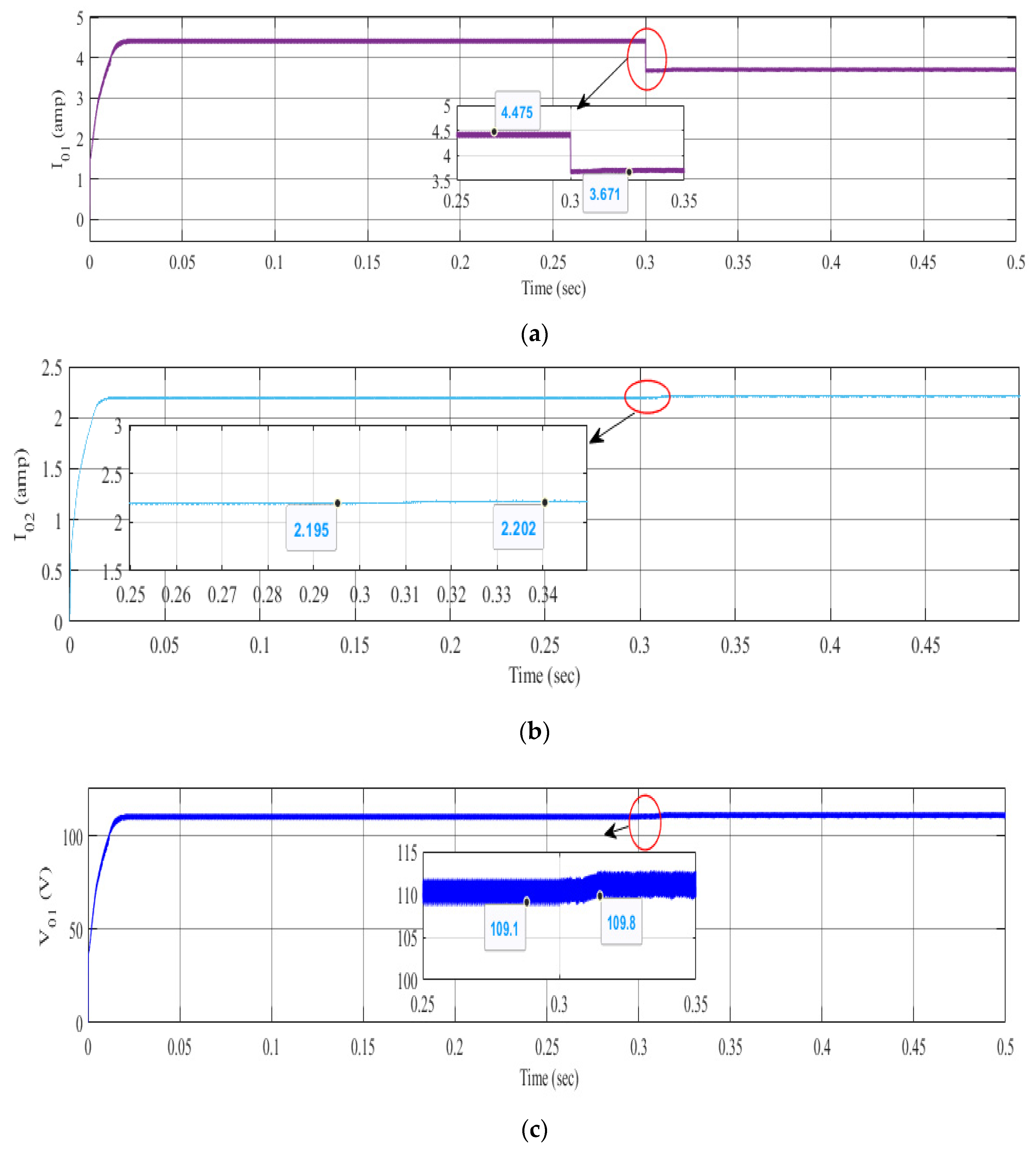
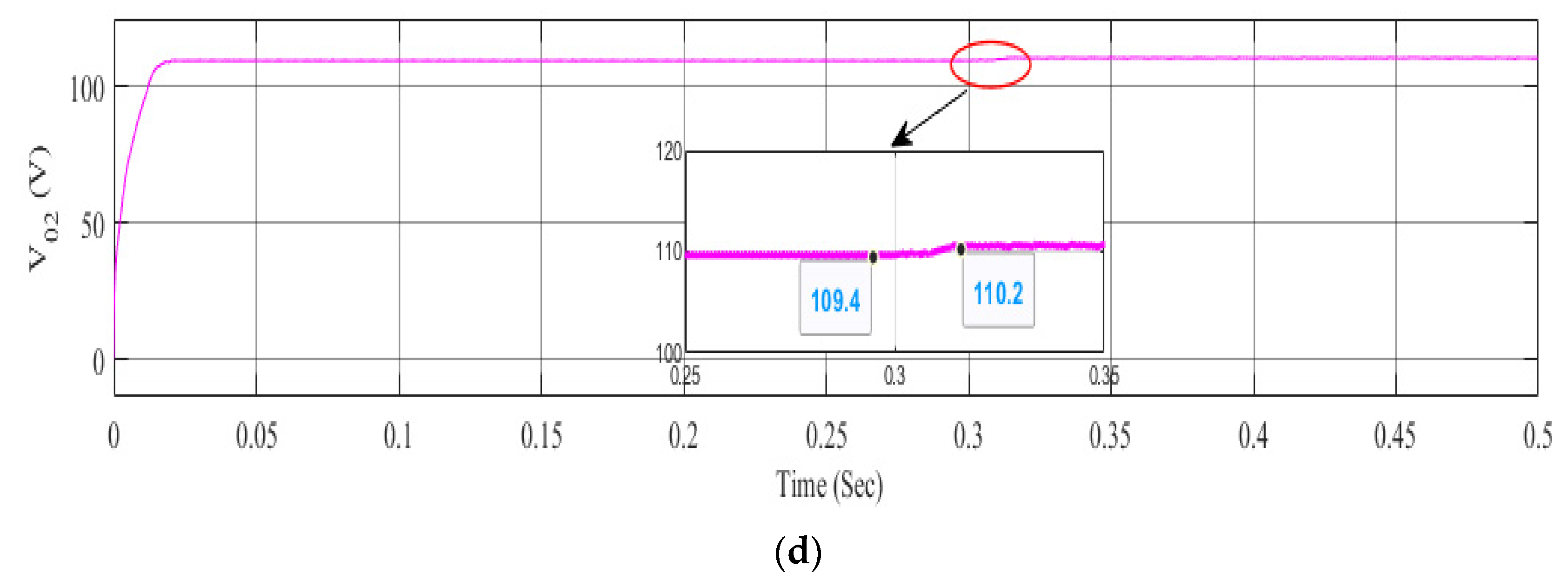
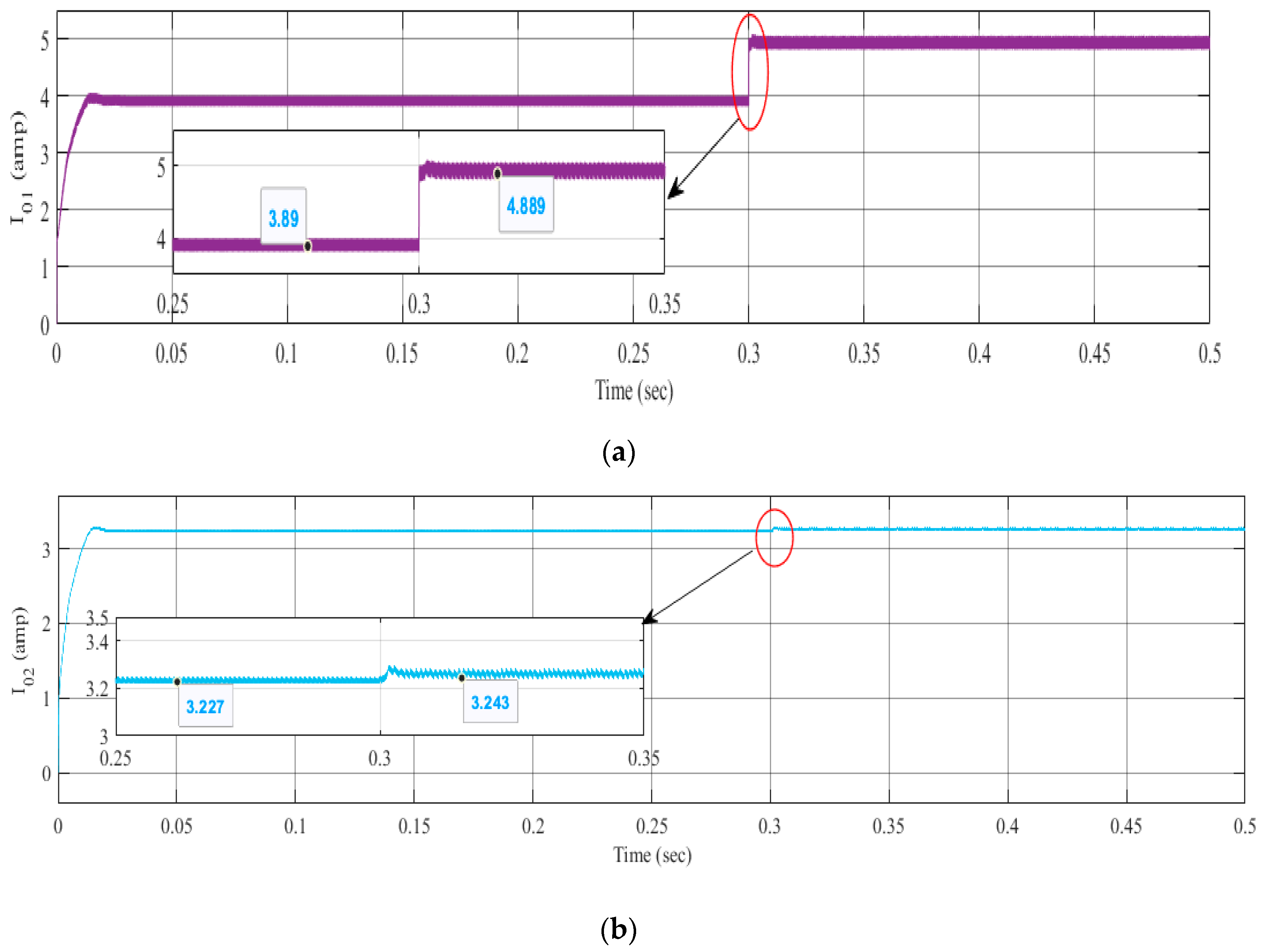
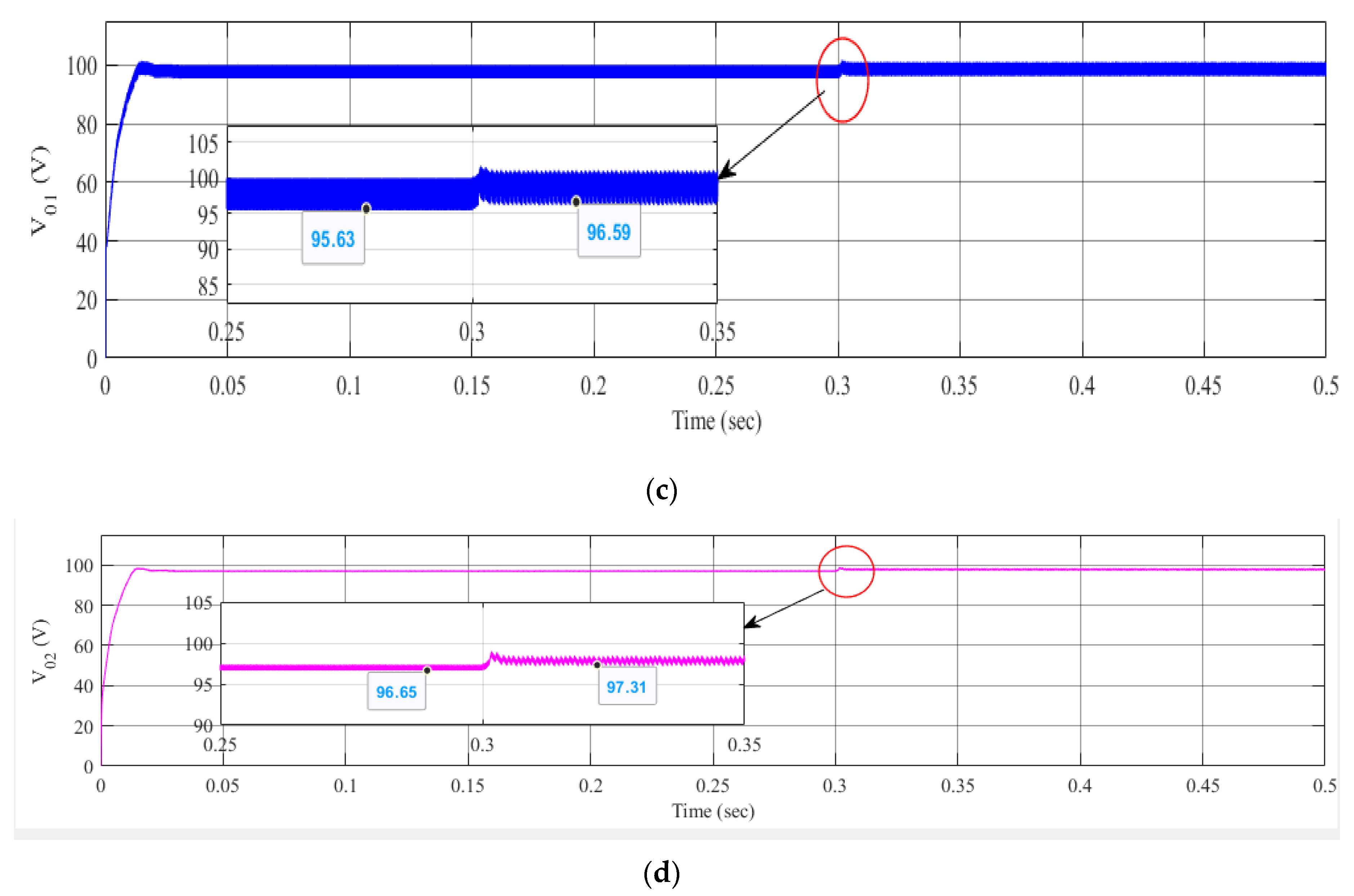
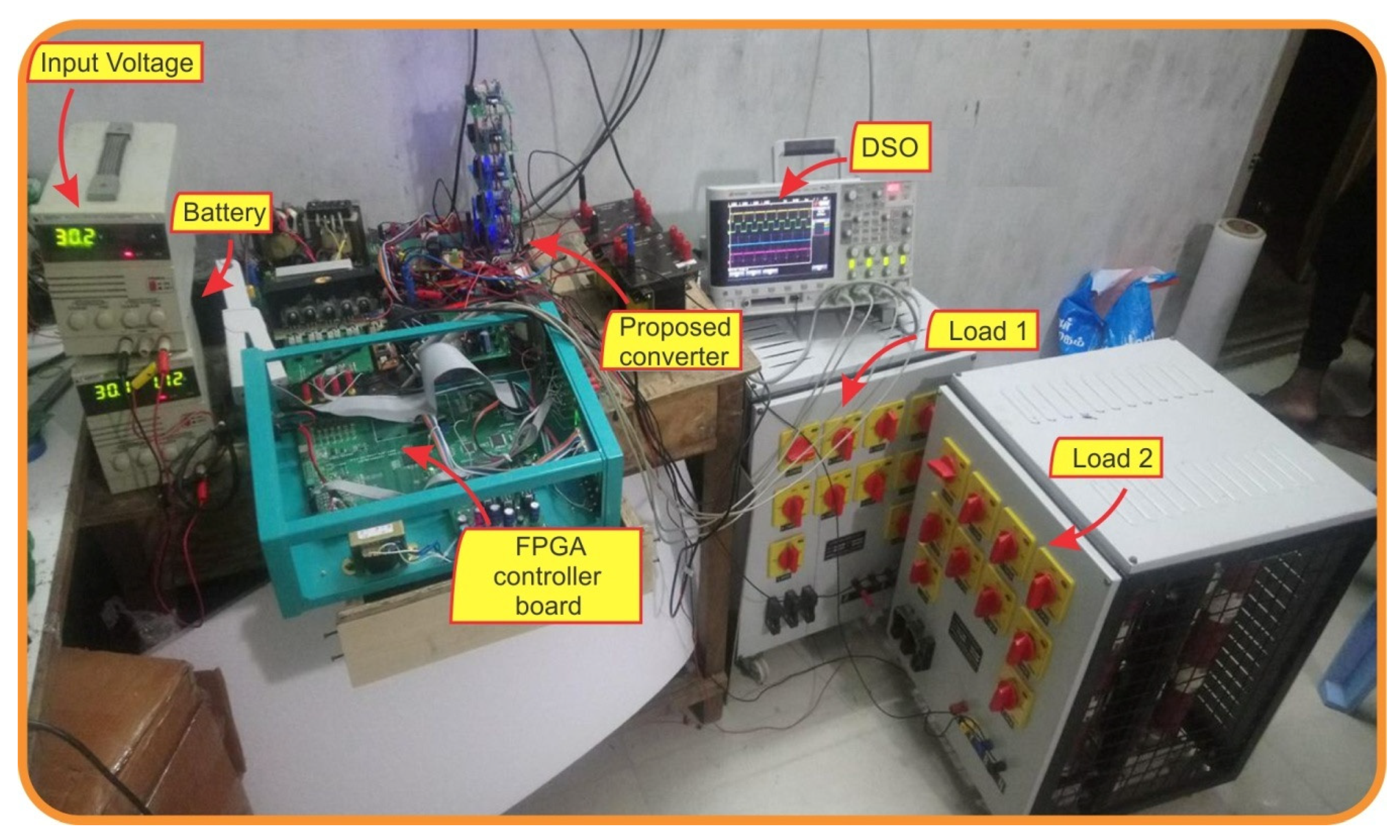
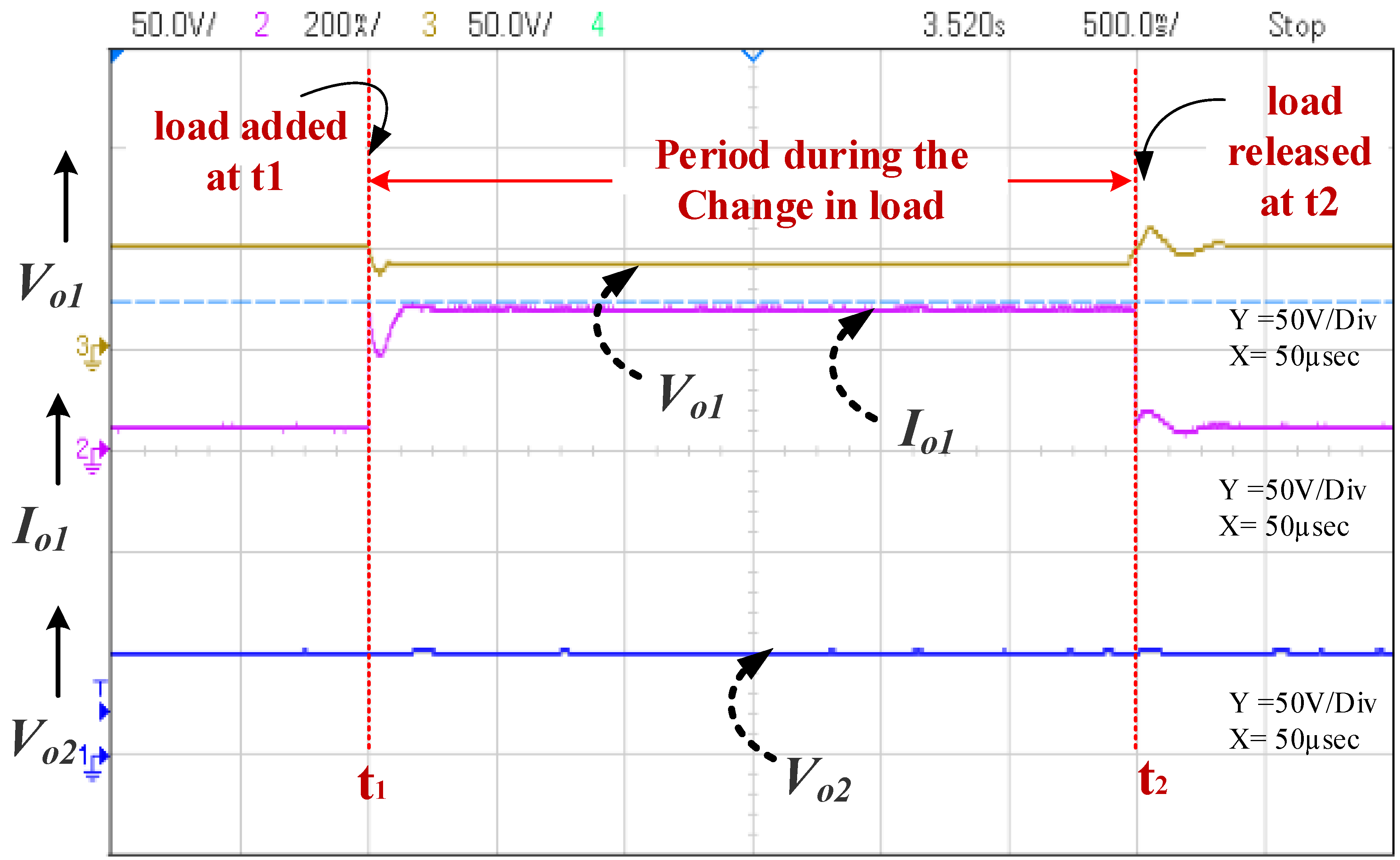
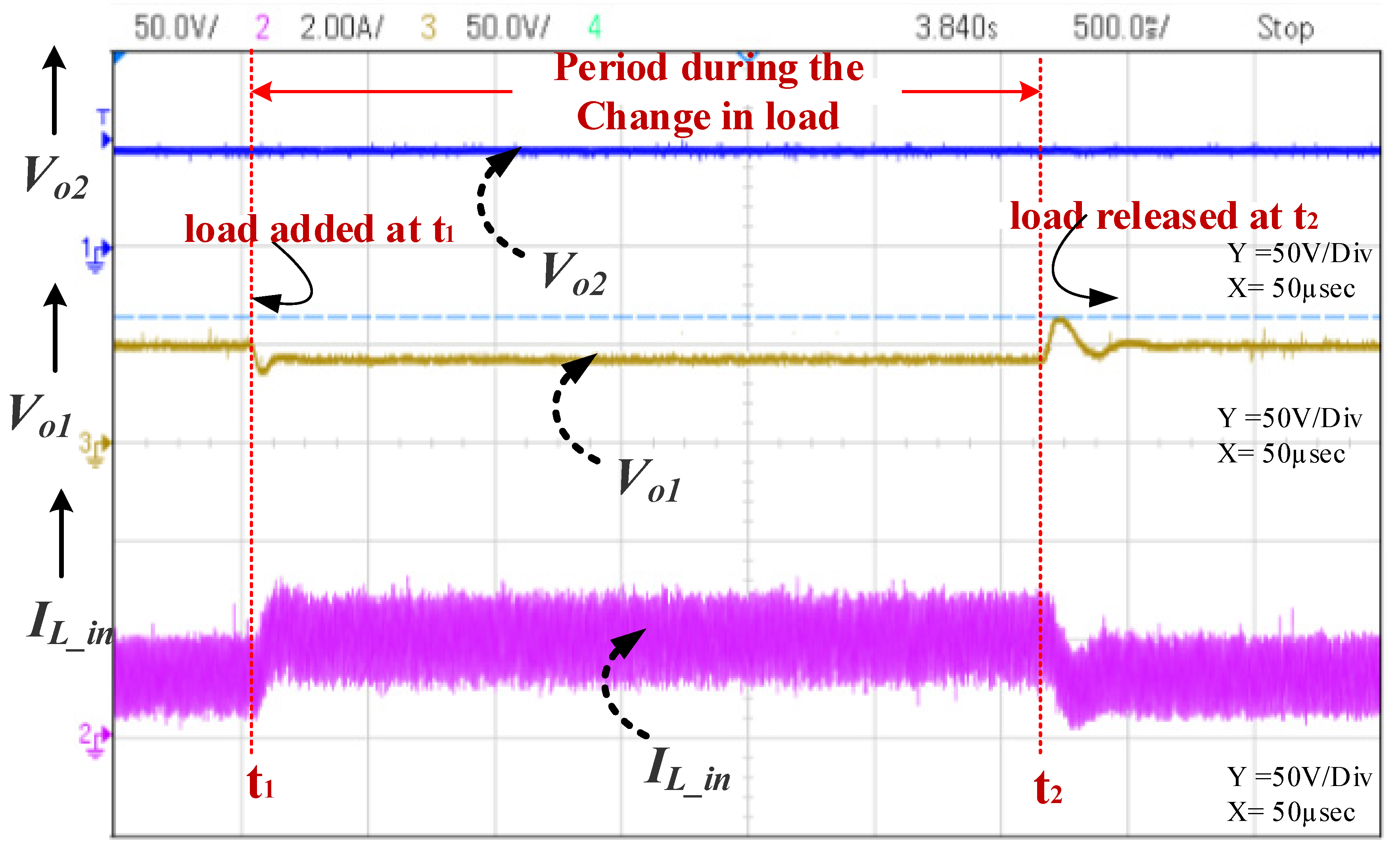
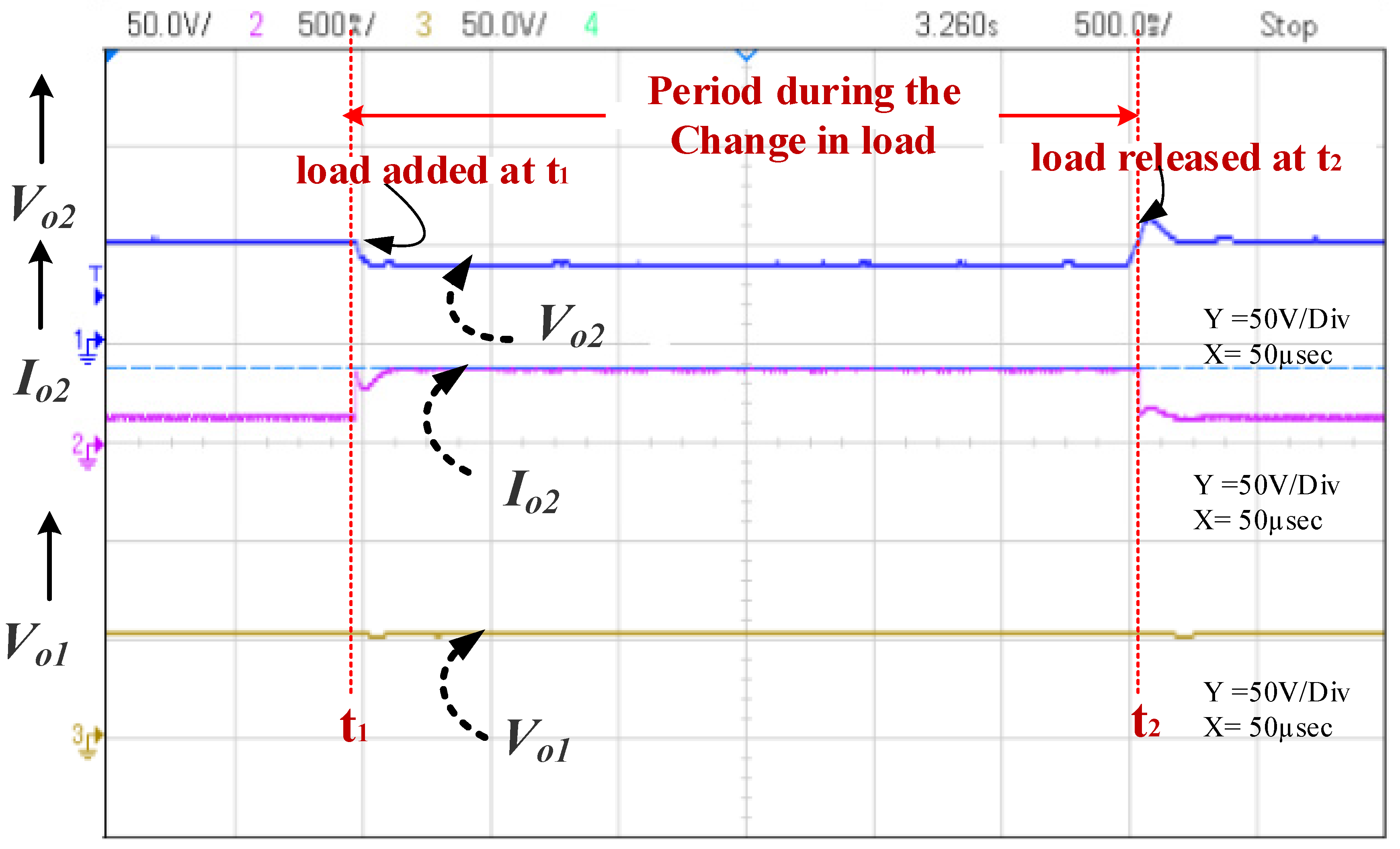

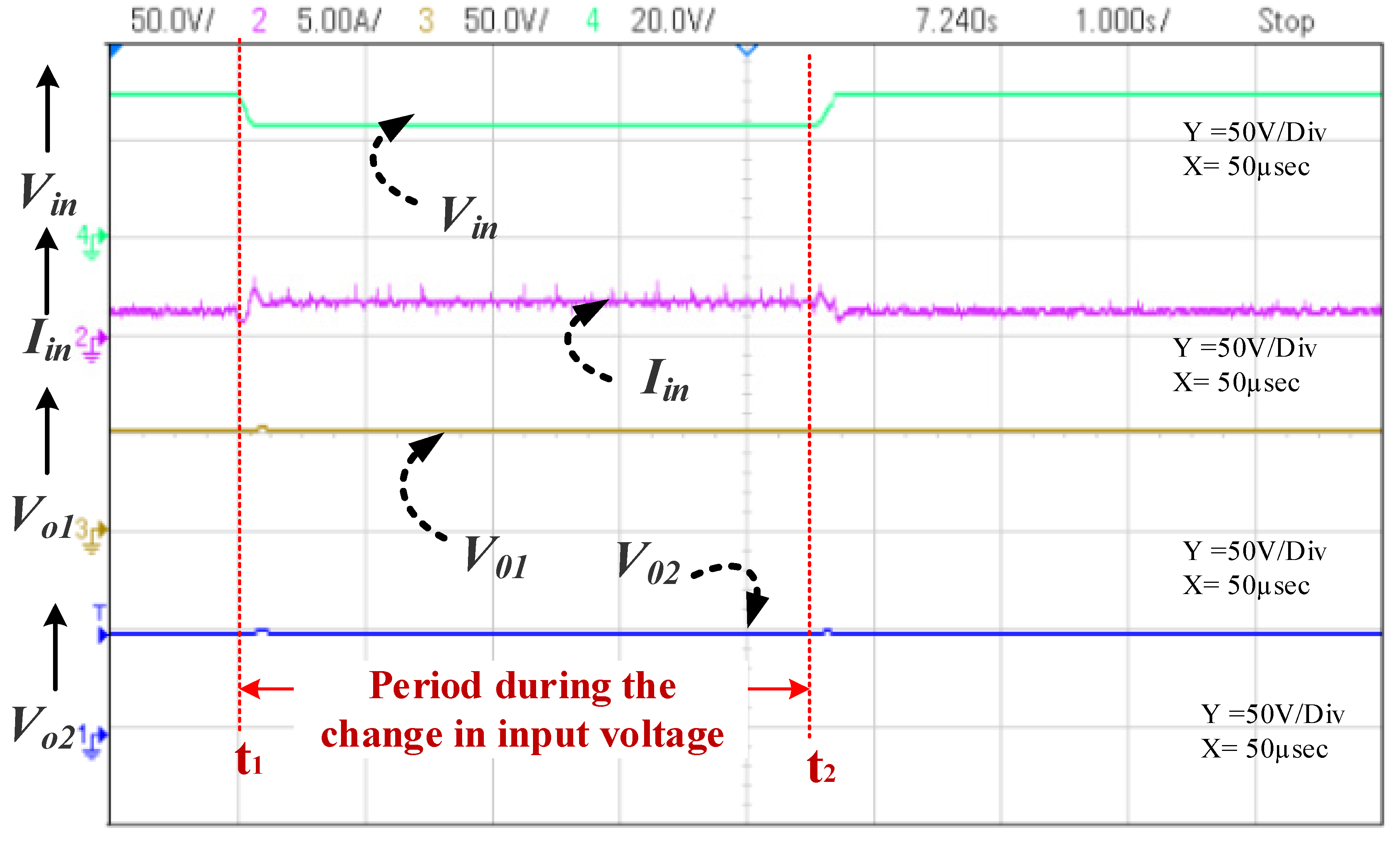
| Modes | Charging and Discharging for Battery | Control Switch | Load Switches | Converter Parameters | Remarks | |||
|---|---|---|---|---|---|---|---|---|
| S1 | S2 | S3 | S4 | S5 | L | C | ||
| Mode 1 | OFF | OFF | ON | OFF | OFF | Charging | Charging | L, C → forms a parallel connection and gets charged. C01 and C02 → discharges to the load. |
| Mode 2 | ON | OFF | OFF | ON | OFF | Discharging | Discharging | L, C → forms a series connection and discharges to the load. C01 → charge. C02 → discharge to the load. |
| Mode 3 | OFF | ON | OFF | OFF | ON | Discharge to the load and charges the battery | Discharging | L, C → discharges. C01 → discharges to the load. C02 → charges. Battery → gets charged through inductor. |
| Vin (V) | VB (V) | L (mH) | C (µF) | C01 (µF) | C02 (µF) | Freq. (KHz) | R1 (Ω) | R2 (Ω) | D1 | D2 |
|---|---|---|---|---|---|---|---|---|---|---|
| 40 | 20 | 1 | 680 | 680 | 680 | 100 | 25 | 20 | 0.5 | 0.2 |
| Controller | Change in Load Resistor R01 (Ω) | Change in Output Current I01 (amp) | Change in Output Current I02 (amp) | Change in Output Voltage V01 (V) | Change in Output Voltage V02 (V) | Cross -Regulation |
|---|---|---|---|---|---|---|
| PID | 25–50 | 4.08–2.117 | 4.63–4.728 | 102.2–105.8 | 92.69–94.41 | 0.02 |
| 25–30 | 4.08–3.445 | 4.631–4.66 | 102.1–103.3 | 92.7–93.22 | 0.008 | |
| 25–20 | 4.08–5.021 | 4.636–4.595 | 102.1–100.3 | 92.74–91.76 | 0.006 | |
| DMPC | 25–50 | 4.401–2.233 | 2.189–2.203 | 108.6–109.8 | 109.4–110 | 0.006 |
| 25–30 | 4.475–3.671 | 2.195–2.202 | 109.1–109.8 | 109.4–110 | 0.004 | |
| 25–20 | 3.89–4.889 | 3.227–3.243 | 95.63–96.59 | 96.65–97.31 | 0.003 |
| S.N0 | Parameters | [This Paper] | [29] | [23] | [14] | [15] | [15] |
|---|---|---|---|---|---|---|---|
| 1 | Input Voltage | 40 V, 20 V | 24, 20 V | 12 V | 5 V | 5 V | 4.8 V |
| 2 | Output Voltage | 103 V, 96 V | 12, 8 V | 1.2 V, 1.5 V | 2.5V, 3.3V | 1 V, 1.5 V | 3.3 V, 1.2 V |
| 3 | Output Power | 250 W | 35 W | ~0.76 W | ~1.5 W | 1.25 W | 0.78 W |
| 4 | Control method | Digital Model Predictive controller | Model Predictive control | Multivariable PID and LQR controller | Average current mode and charge control | Decoupling method | Cross -derivative state feedback |
| 5 | Switching frequency | 100KHz | 20–100 KHz | 10 KHz | 500 KHz | 500 KHz | 100KHz |
| 6 | Inductor | 1 mH | 100 µH | 1 mH | 4 µH | 5 µH | 10 µH |
| 7 | Capacitor | 680 µF | 220 µF | 220 µF | 10 µF | 10 µF | 10 µF |
| 8 | Step change in Output Current | 4.401-2.233 A @I01 | 8–10 V@V2 | 0.5–1.05 A @I02 | 1 A @I01 | 500–250 mA @I01 | 100–200 mA @I01 |
| 4.475- 3.671 A @I01 | 0.61–0.8 A @I1 | 2–2.5 A @I02 | 1 A @I02 | 250–500 mA @I01 | 100–200 mA @I02 | ||
| 9 | Cross- Regulation | 0.006A @I02 | 0.025 | 1.2 V @0.01s | 0.5 A @I02 | 0.02 | 0.03 |
| 0.004A @I02 | - | 3.3V @0.007s | 0.66 A @I01 | 0.01 | 0.008 | ||
| 10. | Sensitivity | 0.012 | 0.017, 0.016 | 0.83 | 0.05 | 0.01 | 0.01 |
| Step Change in load 1 | t (sec) | I01 (mA) | V01 (V) | I02 (mA) | V02 (V) | Cross-regulation |
| t1 = 1 | 0.1–0.4 | 50–49 | ~0.1 | ~50 | 0.001 | |
| t2 = 4 | 0.4–0.1 | 49–50 | ~0.1 | ~50 | ||
| Step Change in load 2 | t (sec) | I02 (mA) | V02 (V) | I01 (mA) | V01 (V) | |
| t1 = 1 | 0.1–0.4 | 50–49 | ~0.1 | ~49.8 | 0.002 | |
| t2 = 4 | 0.4–0.1 | 49–50 | ~0.1 | ~49.8 | ||
| Input Voltage Variation | t (sec) | Vin (V) | Iin (mA) | V01 (V) | V02 (V) | |
| t1 = 1 | 30–25 | 1–2 | ~50 | ~50 | 0.001 | |
| t2 = 5.8 | 25–30 | 2–1 | ~50 | ~50 |
Publisher’s Note: MDPI stays neutral with regard to jurisdictional claims in published maps and institutional affiliations. |
© 2020 by the authors. Licensee MDPI, Basel, Switzerland. This article is an open access article distributed under the terms and conditions of the Creative Commons Attribution (CC BY) license (http://creativecommons.org/licenses/by/4.0/).
Share and Cite
Kamaraj, V.; Chellammal, N.; Chokkalingam, B.; Munda, J.L. Minimization of Cross-Regulation in PV and Battery Connected Multi-Input Multi-Output DC to DC Converter. Energies 2020, 13, 6534. https://doi.org/10.3390/en13246534
Kamaraj V, Chellammal N, Chokkalingam B, Munda JL. Minimization of Cross-Regulation in PV and Battery Connected Multi-Input Multi-Output DC to DC Converter. Energies. 2020; 13(24):6534. https://doi.org/10.3390/en13246534
Chicago/Turabian StyleKamaraj, Vibha, N. Chellammal, Bharatiraja Chokkalingam, and Josiah Lange Munda. 2020. "Minimization of Cross-Regulation in PV and Battery Connected Multi-Input Multi-Output DC to DC Converter" Energies 13, no. 24: 6534. https://doi.org/10.3390/en13246534
APA StyleKamaraj, V., Chellammal, N., Chokkalingam, B., & Munda, J. L. (2020). Minimization of Cross-Regulation in PV and Battery Connected Multi-Input Multi-Output DC to DC Converter. Energies, 13(24), 6534. https://doi.org/10.3390/en13246534







